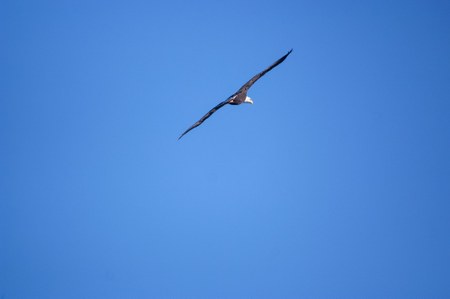
A shadow darkens the window – a heartbeat of dim sunlight. I look up to see a large bird, a raptor, glide against the sky, wings stretched wide to catch a breeze. Squinting against the light, I catch the distinctive white head and tail before the eagle flicks a few feathers, banks right, and disappears. The train continues racing north to home while my gaze falls back to the shoreline looking for birds and animals, my little time with nature on my commute.
Like many Mountaineers, my time spent in nature is limited to what I can squeeze out between workdays sitting at a desk staring at a computer. Home is in Edmonds, work is in Pioneer Square, and the easiest, most convenient transportation back and forth is the Sounder north line commuter train running along the shore of Puget Sound. While it would be easy to become engrossed in a book or a conversation during the commute, I’ve found it more captivating to watch the scenery roll by and try to identify the various birds that migrate through or live in the Sound.
The world slips by as the train rumbles down the track at 60 miles per hour and bird identification seems near impossible. Birders are generally quiet folk, sitting still to wait for their quarry to come within view. But there are also 50-mile-an-hour birds. These are birds whose markings and shapes are so distinctive that you can identify them as you drive through the country at highway speeds. Our friend the Bald Eagle is one such bird, with its great wingspan and definitive white head and tail. Either flying or roosting, their white feathers are like a beacon signaling their presence. As the train speeds north, other distinctive birds are checked off my list: Great Blue Heron standing regal and tall at water’s edge, Cormorants resting on top of old pilings, wings outstretched to dry their feathers, Canada Geese, their necks ringed with white, bobbing in the waves.
I’ll also watch for interesting behaviors. How are the birds acting, or interacting with each other? Watching a gull wrestle with a flounder it had caught had me wondering who would win – the flounder’s tail flapped with enough strength to shake the gull’s head. A Bald Eagle standing on the beach in a circle of crows looked as if it was giving a pep talk to a Corvid sports team. Seeing flotillas of various wintering ducks undulating in the waves, I look for distinguishing marks only to find several breeds swimming along the shore in friendly comradery. Peering more closely at a gull swimming around a rock, I realize that the rock is a seal. Could they be playing? Or are they vying for a delectable tidbit in the water?
Yes, seals play in the water close to shore, and I can usually spot a dog-shaped head peering out of the water to watch the train go by at least once a week. Then there are the lucky days where I can spot several along the route home – six has been my record. I’m still looking for an otter though. And always searching the space between the shore and the distant Olympic Mountains for a breaching whale. Now that would be cool.
Becoming a commuter naturalist is quite easy. It’s all about engaging with the passing world through your window. Look in the sky for birds soaring on breezes and note their shape. Look into greenery along the route and note the textures of the trees and ferns. A connection with nature can happen in the long days between adventures, even if it’s just noting the change of seasons in the color of the leaves.
This article originally appeared in our Fall 2019 issue of Mountaineer Magazine. To view the original article in magazine form and read more stories from our publication, click here.
 Heidi Walker
Heidi Walker